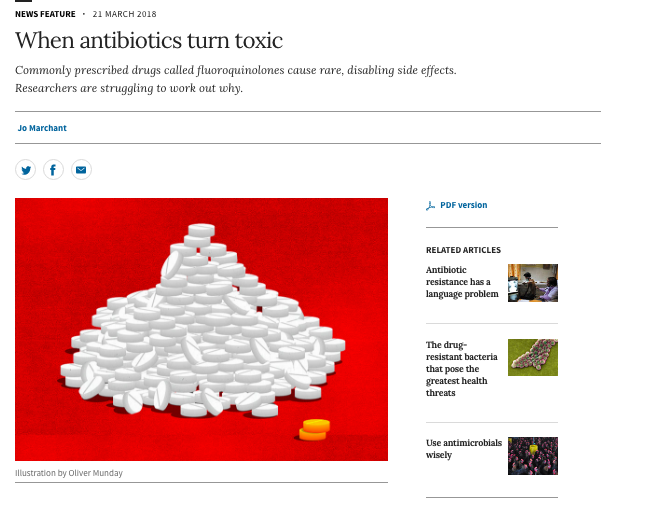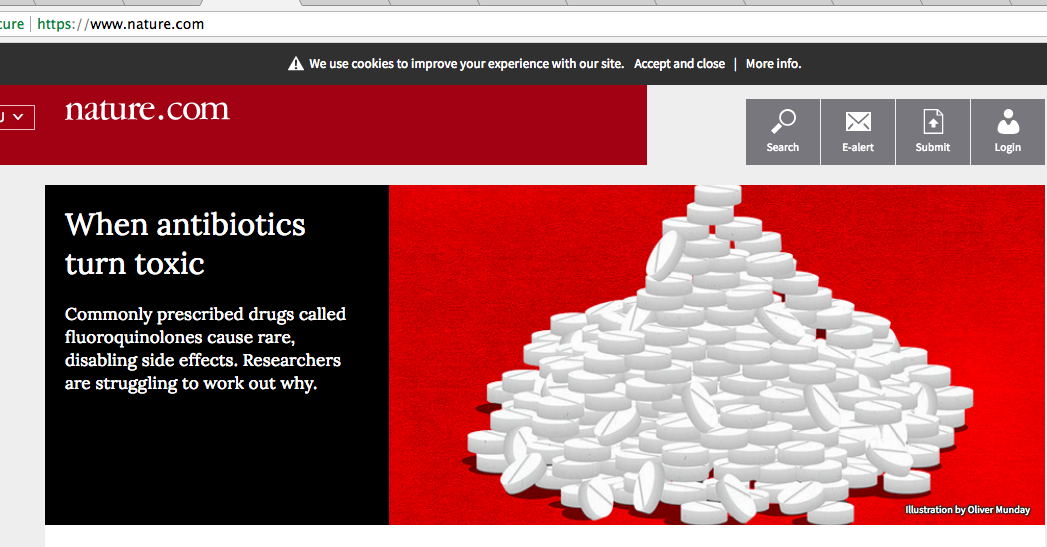Fluoroquinolone toxicity is highlighted and featured in NATURE – one of the oldest, most reputable, journals in the world. This is so exciting!!
You can read the article, When antibiotics turn toxic, that was published in Nature on March 21, 2018 HERE.
Here are some highlights from the Nature article:
First, thank you to Dr. Miriam van Staveren whose story was told in the Nature article. She is a physician and a fellow “floxie.” Even as a physician, she had trouble getting her experience of being poisoned by Levofloxacin acknowledged:
“Since then, she has seen a variety of medical specialists. Some dismissed her symptoms as psychosomatic. Others suggested diagnoses of fibromyalgia or chronic fatigue syndrome. Van Staveren is in no doubt, however. She’s convinced that the antibiotic poisoned her.”
Second, the article mentions Fluoroquinolone Toxicity and Fluoroquinolone Associated Disability (FQAD) by name. This is huge! Rather than calling what we are experiencing something like, “a rare adverse reaction,” it is referred to as fluoroquinolone toxicity or FQAD. This is subtle acknowledgement that what we are going through is a syndrome–a thing in itself–not just a “side-effect” to be dismissed.
Third, even though the word “rare” is used throughout the article, and I know that this is annoying and off-putting for all of us who see that fluoroquinolone toxicity is NOT RARE, the article also notes that the frequency of fluoroquinolone toxicity is higher than many assume:
“From the 1980s to the end of 2015, the FDA received reports from more than 60,000 patients detailing hundreds of thousands of ‘serious adverse events’ associated with the 5 fluoroquinolones still on the market (most commonly tendon rupture, as well as neurological and psychiatric symptoms), including 6,575 reports of deaths. The FDA says that the reports of adverse events it receives — sent in by drug manufacturers, by doctors and directly by consumers — cannot be used to reach conclusions about the severity of problems associated with drugs. Still, the fluoroquinolones have attracted more complaints than other more widely used antibiotics. And only 1–10% of adverse events are estimated to be reported to the FDA, suggesting that fluoroquinolones might have harmed hundreds of thousands of people in the United States alone, says Charles Bennett, a haematologist at the University of South Carolina’s College of Pharmacy in Columbia. Bennett is also director of the Southern Network on Adverse Reactions, a state-funded pharmaceutical-safety watchdog, which has been working with people affected by fluoroquinolones since 2010.”
Fourth, mitochondrial damage is noted as a cause of fluoroquinolone toxicity:
“Accumulating evidence, Golomb says, suggests that fluoroquinolones are damaging mitochondria, the power packs inside human cells that evolved from symbiotic, bacteria-like cells billions of years ago. This kind of harm can affect every cell in the body, explaining why a wide range of symptoms can appear and get worse over time.”
Fifth, the article noted that Dr. Charles Bennett, may have found some genes shared by people who are hurt by fluoroquinolones:
“At a conference last September, Bennett reported preliminary data that might hint at why only some people develop serious side effects from fluoroquinolones. He took saliva samples from 24 people who reported neuropsychiatric side effects — such as memory loss, panic attacks and depression — and found that 13 of them (57%) shared a gene variant usually seen in only 9% of the population.”
If there are genes that make people more succeptible to disabling fluoroquinolone toxicity, perhaps those can be tested for before fluoroquinolone prescriptions are written.
Sixth, the article notes the obstacles that scientists, researchers, and doctors face when they question and investigate adverse drug reactions. It is noted that little support or funding for adverse drug reaction research is available, and that many scientists face push-back from pharmaceutical companies when they attempt to research fluoroquinolone toxicity.
Last, Floxie Hope was mentioned in the article. Squeee! What an honor and a privilege to be mentioned in an article in Nature!
“On websites and Facebook groups with names such as Floxie Hope and My Quin Story, thousands of people who have fallen ill after fluoroquinolone treatment gather to share experiences. Many of them describe a devastating and progressive condition, encompassing symptoms ranging from psychiatric and sensory disturbances to problems with muscles, tendons and nerves that continue after people have stopped taking the drugs. They call it being ‘floxed’.”
Those seven points are the highlights of the article, in my opinion, but I suggest that each of you read the article yourself. It’s currently (03/25/18) on the home-page of nature.com. Squee!
*****













… [Trackback]
[…] Read More to that Topic: floxiehope.com/fluoroquinolone-toxicity-featured-in-nature/ […]
… [Trackback]
[…] Info on that Topic: floxiehope.com/fluoroquinolone-toxicity-featured-in-nature/ […]
… [Trackback]
[…] Find More on that Topic: floxiehope.com/fluoroquinolone-toxicity-featured-in-nature/ […]
… [Trackback]
[…] Read More to that Topic: floxiehope.com/fluoroquinolone-toxicity-featured-in-nature/ […]
… [Trackback]
[…] Here you will find 60605 more Info to that Topic: floxiehope.com/fluoroquinolone-toxicity-featured-in-nature/ […]
… [Trackback]
[…] Information to that Topic: floxiehope.com/fluoroquinolone-toxicity-featured-in-nature/ […]
… [Trackback]
[…] Here you can find 97187 additional Information to that Topic: floxiehope.com/fluoroquinolone-toxicity-featured-in-nature/ […]
… [Trackback]
[…] Find More here on that Topic: floxiehope.com/fluoroquinolone-toxicity-featured-in-nature/ […]
… [Trackback]
[…] Information on that Topic: floxiehope.com/fluoroquinolone-toxicity-featured-in-nature/ […]